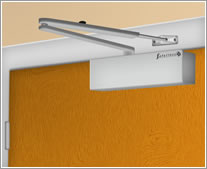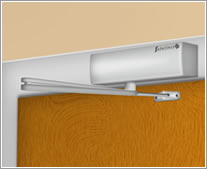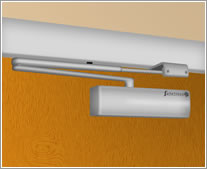-
Contact
Sales & Customer Service
0800 612 6537 support@safelincs.co.uk Live ChatDelivery Enquiries
0800 077 6149 - Resources
Fire & Safety Solutions
CALL OUR TEAM NOW 0800 612 6537
Lines open today 8am - 6pm
FREE Delivery
on marked products
Live Chat - Online
Instant help & Advice
Trade Discounts
and exclusive pricing
0% Credit Available
Open an account now
5 Star Customer Feedback
Overhead Fire Door Closers
Fire door closers close fire doors behind a person passing through the door and therefore help limit the spread of fire throughout a building. Overhead fire door closers can be mounted in three different configurations which are commonly referred to as Fig 1, 61 and 66 positions (please note that not all closers can be mounted in all configurations).
Fire door closers come either with a rated or adjustable strength to cater for different sizes and weights of doors. View our EN size guide
GEZE TS2000 NV Overhead Door Closer - Power Size EN 2-4
- Adjustable power size EN 2-4
- 120 minute fire rating
- Adjustable closing speed and latching action
- Standard closer or adjustable back check available
- 12 Month Warranty
Union CE3F Overhead Door Closer - Power Size EN 3
- This product qualifies for FREE shipping!
- Fixed power size EN 3
- 120 minute fire rating for timber fire doors
- Adjustable closing speed and latching action
- 10 Year Warranty
GEZE TS1000C Overhead Door Closer - Power Size EN 2 - 3
- Adjustable power size EN 2 - 3 via installation
- 120 minute fire rating
- Adjustable closing speed and latching action
- 12 Month Warranty
Dorma TS68 Overhead Door Closer - Power Size EN 2-4
- Selectable power size EN 2-4
- 120 minute fire rating
- Adjustable closing speed and latching action
- 5 year warranty
Briton 121CE Overhead Door Closer - Power Size EN 3
- Fixed power size EN 3
- 120 minute fire rating
- Adjustable closing speed and latching action
- 10 Year Warranty
Union CE24V Overhead Door Closer - Power Size EN 2 - 4
- Adjustable power size EN 2-4
- 120 minute fire rating
- Adjustable closing speed, latching action and back check
- 10 year warranty
Briton 1110 Overhead Door Closer - Power Size EN 2-4
- Adjustable power size EN 2-4
- 120 minute fire rating
- Adjustable closing speed and latching action
- 10 year warranty
Dorma TS71 Overhead Door Closer - Power Size EN 3-4
- Selectable power size EN 3-4
- 120 minute fire rating
- Adjustable closing speed and latching action
- 5 year warranty
GEZE TS1500 Overhead Door Closer - Power Size EN 3 - 4
- Adjustable power size EN 3-4
- 120 minute fire rating
- Adjustable closing speed and latching action
- Standard closer and guide rail options available
- 12 Month Warranty
Dorma TS72 Overhead Door Closer - Power Size EN 2-4
- Adjustable power size EN 2-4
- 120 minute fire rating
- Adjustable closing speed and latching action
- Standard closer or adjustable back check available
- 5 year warranty
ASSA ABLOY DC140A Overhead Door Closer - Power Size EN 2-5
- Adjustable power size EN 2-5
- 120 minute fire rating
- Adjustable closing speed, latching action, and back check
- Supplied with fixings for all three mounting configurations
- 10 Year Warranty
Union RetroV Overhead Door Closer - Power Size EN 3 - 4
- Adjustable power size EN 3-4
- 60 minute fire rating for timber doors
- Adjustable closing speed and latching action
- Available in silver finish
- 10 year warranty
Briton 1120B Overhead Door Closer - Power Size EN 2-4
- Adjustable power size EN 2-4
- 120 minute fire rating
- Adjustable closing speed, latching action & back check
- 10 year warranty
Briton 2003 Overhead Door Closer - Power Size EN 3
- Fixed power size EN 3
- 120 minute fire rating
- Adjustable closing speed and latching action
- Available in a silver finish
- 10 year warranty
Briton 2003V Overhead Door Closer - Power Size EN 1 - 4
- Adjustable power size EN 1-4
- 120 minute fire rating
- Adjustable closing speed, latching action & back check
- Available in silver finish
- 10 year warranty
Union CE26V Overhead Door Closer - Power Size EN 2 - 6
- Adjustable power size EN 2-6
- 120 minute fire rating
- Adjustable closing speed, latching action and back check
- 10 year warranty
GEZE TS4000 Overhead Door Closer - Power Size EN 1-6
- Adjustable power size 1-6
- 120 minute fire rating
- Adjustable closing force, speed, latching action and back check
- 12 Month Warranty
Dorma TS83 Overhead Door Closer - Power Size EN 3-6
- Adjustable power size EN 3-6
- 120 minute fire rating
- Adjustable closing force, speed, latching action and back check
- Available with adjustable delayed closing action
- 5 year warranty
Exidor 9870 Electro-Magnetic Free-Swing Door Closer - Power Size EN 4
- Fixed power size EN 4
- Door operates without resistance in normal use
- Adjustable closing speed and latching action
- Free-swing and hold open configuration options
- 2 year warranty
GEZE TS4000E Hold Open Door Closer - Closing Force EN 1-6
- Adjustable power size EN 1-6
- 120 minute fire rating
- Adjustable closing speed and latching action
- Manufacturer's 12 month warranty
Page 1 (20 of 28 Products)
Overhead Fire Door Closer Mounting Configurations
Overhead Fire Door Closer Mounting Configurations
Door closers can be mounted in different ways depending upon the application for which they are being used. The three most common mounting types are detailed below.
Fig 1 Mounting |
|
|---|---|
|
Also known as regular or projecting arm, this is the standard fixing position for a universal door closer. This is where the door closer is fitted to the opening face of the door on the hinge side. When a door closer is fitted in a "figure 1" configuration the arms of the closer will project outwards from the door at around 90°. Please Note: Fig 1 is suitable for all fire doors. |
 |
Fig 61 Mounting |
|
|
The second fixing position for a universal door closer is commonly referred to as "figure 61" or transom. This is where the door closer is inverted and the body of it fitted to the head of the door frame opposite the hinge side of the door. This application allows a door closer to be fitted on external doors without the closer having to be exposed to the elements. When a door closer is fitted in a "figure 61" configuration the arms of the closer will project outwards from the door at around 90°. Please Note: The Certifire certificate must explicitly state approval for a door closer to be compliant in this configuration. |
 |
Fig 66 Mounting |
|
|
The third fixing position for a universal door closer is commonly referred to as "figure 66" or parallel arm. This is where the door closer is fitted to the closing face of the door opposite the hinge side of the door. The arm of the closer is then fitted to a bracket supplied with the door closer. This application allows a door closer to be fitted on external doors without the closer having to be exposed to the elements. When a door closer is fitted in a "figure 66" configuration the arms of the closer will run parallel to the door and frame. Please Note: The Certifire certificate must explicitly state approval for a door closer to be compliant in this configuration. |
 |






































